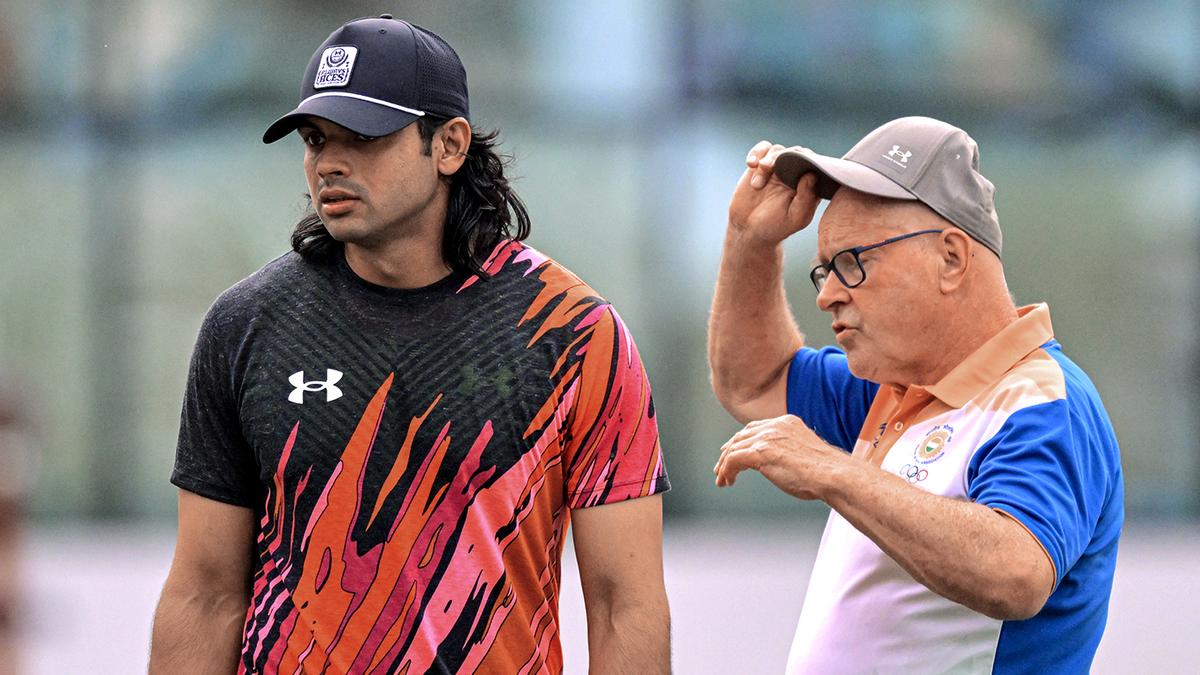Klaus Bartonietz: Neeraj can win another Olympic medal; Sachin should chase consistency, not 90m
At his home in the small village of Oberschlettenbach, nestled in the mountains of southwest Germany, athletics isn’t the top priority right now for 76-year-old javelin coach Klaus Bartonietz. These days, his attention is on his potato harvest. Having planted them in spring, he’s now busy digging them up. “I was thinking I’d get 40 kilos, but I’ve got about 35 kilos. But it’s hard work to get them all out of the ground,” says the septuagenarian with a laugh.
In recent weeks, though, Klaus has been reaping another kind of harvest. He’s just returned from Tokyo, where he coached Keshorn Walcott to his first World Championships gold medal. It was Klaus’s second javelin world title, coming two years after he guided Neeraj Chopra to gold at the Budapest Worlds.
A second world title doesn’t stir much excitement in Klaus. “Life goes on. Of course, I’m satisfied with the effort and the outcome. It’s been effective,” he says matter-of-factly.
For many, the sight of Klaus in the stands of Tokyo’s Olympic Stadium — wearing a cap and T-shirt in the red and black of Trinidad and Tobago — came as a surprise. The German had ended his six-year stint with Neeraj last year, a period in which the Indian star became Olympic champion in Tokyo, World silver medallist in 2022 (Oregon), World champion in 2023 (Budapest), and Olympic silver medallist again in Paris in 2024.
Klaus had said one reason for stepping away was age. Neeraj, too, had moved on, beginning a new phase under world record holder Jan Zelezny.
Klaus admits he expected to spend his days tending to his garden when, late last year, he got a call from Walcott’s manager. “He asked me if I would be willing to work as a consultant for Keshorn. Initially, we were only talking over the phone, and I gave him some advice — about once a week, then once every couple of weeks in winter. He was mostly in the Caribbean, so there wasn’t any way to go there to train him. Then, at the end of April, it happened a couple of times. After that, he had a training camp in Portugal, and that’s when we came together in May,” he recalls.
Whatever they’re doing, it’s working. Walcott, who became the youngest Olympic men’s javelin champion when he won gold in 2012, threw a season’s best of 88.16m to win his first world title, nine years after his last medal at a global event.
Klaus is quick to downplay his role. “I think we really overestimate the contribution of a coach! I can only guess why he wanted to work with me. He wasn’t performing badly — he’s been consistently over 85 metres, and he’s thrown 90 as well. I think he was a little under the radar after 2021 despite those big throws. What I actually did was get him to train a little less. I wanted him to throw less and think more about what he needed to do as a javelin thrower,” he says.
While Klaus expected Walcott to produce some big throws in Tokyo, he hadn’t imagined gold. “I wasn’t expecting that he would win gold. Of course not. I thought maybe he’d throw 86 or 87m in the best case, but I guess it’s not very far from 87 to 88. I was expecting a good result, but I also know anything can happen. Still, it came as a surprise when he won,” he says.
In a World Championships full of surprises, the javelin final was no exception. Walcott became one of the oldest to win the title. World leader Julian Weber failed to make the podium, America’s relatively unknown Curtis Thompson did, and Olympic champion Arshad Nadeem finished 10th.
From an Indian perspective, there was both disappointment and promise. Defending champion Neeraj finished eighth — his first time outside the top two at a major event since 2018 — but the emergence of 25-year-old Sachin Yadav, who came within 40 centimetres of a podium finish on debut, offered reason for optimism.
Klaus has high praise for Sachin. “I wouldn’t have been surprised if Sachin had won a medal. Half a metre more and he would have been on the podium. He was already over 86 metres and at that distance, 40 centimetres is nothing,” he says.
At 6’5” and nearly 110 kilograms, Sachin combines size and strength with technique, says Klaus. “He’s very tall. That’s a great benefit, but he’s also technically very sound. These guys are all strong, but it’s not about how much you can lift or sprint. Sachin’s best points are that he’s both powerful and technically good. He has a very stable front leg and great coordination,” he adds.
“Sachin shouldn’t chase 95m”
Klaus doesn’t think Sachin’s 86.27m throw in Tokyo will remain his Personal Best for long. “Do I think he can throw 90 metres? Of course he can. It’s very possible,” he says.
But he cautions against obsession with distance. “I don’t even think 95 metres is impossible for Sachin. But you need to be realistic. Neeraj threw 86m in 2016 and it took him nearly nine years to get to 90 in competition. Neeraj started young. He was 18 when he threw 86m. Sachin is around 24 or 25. And the road to 95m is very stony. It takes a lot out of you. (Johannes) Vetter threw 97m and paid the price with his body. That number can play with your head too,” he says.
Technical strength: “These guys are all strong, but it’s not about how much you can lift or sprint. Sachin’s best points are that he’s both powerful and technically good” — Klaus Bartonietz.
| Photo Credit:
REUTERS
Technical strength: “These guys are all strong, but it’s not about how much you can lift or sprint. Sachin’s best points are that he’s both powerful and technically good” — Klaus Bartonietz.
| Photo Credit:
REUTERS
Instead, Klaus wants Sachin to stabilise his current level. “We should avoid all this talk of 90 metres. It should be about consistency. We had this young German (Max Dehning) who threw 90 but now he’s at 75. All this hype about metres is useless. It’s counterproductive. Sachin needs to stabilise at 85–86m, as Neeraj did around 88. If he can throw 85–86m anytime, he’ll always be in contention for the Commonwealth Games and the Olympics,” he says.
Neeraj can still win Olympic gold
Neeraj, Klaus believes, will remain in the mix for the Los Angeles Games. The Tokyo result was a setback, but Klaus admits the injury Neeraj suffered beforehand made things difficult. “I didn’t speak much to him after the final. He looked very upset and disappointed, and it’s hard to know what to say then. He’s a good sportsperson. He congratulated Keshorn and said he’d do better. I think he had some health problems and couldn’t train for two weeks. He was very good in qualification but couldn’t repeat it the next day. Sometimes it’s just luck,” he says.
Could Neeraj have trained differently to avoid injury? Klaus refuses to speculate. “I don’t know what the training program looks like, so I can’t say he should have done something differently. Injuries are unpredictable. There’s always a risk when you’re training. Neeraj once aggravated his groin injury making a very easy throw. Once he fractured his finger doing hurdle jumps. If you don’t want to get injured, stay home — and then you might fall down the stairs!” he laughs.
What Klaus hopes Neeraj can avoid, though, is the pressure. “There’s so much pressure on him. I’d suggest to Indians: put less pressure on your athletes. Enjoy them and let them enjoy the competition. There’s no point giving them advice from outside,” he says. What also bothered him was the hype around the 90m barrier. “Everyone made it out to be a kind of club. That influences the public and reaches the athlete. Of course, at Worlds and Olympics, there’s always pressure, but the extra noise doesn’t help,” he says.
Neeraj has handled that noise well for years, but this time things didn’t fall into place. “He was surely one of the contenders for a medal. He was the World champion and Olympic silver medallist, but now he’s the hunted,” says Klaus.
Still, Klaus believes Neeraj has it in him to return to the podium. “He has the capacity to win another Olympic medal. Jan Zelezny did it three times, so he knows what it takes mentally. Neeraj’s still young, 27 or 28. He aims high but isn’t overconfident — that’s important. He’s dealt with injury before, and he’s thrown 90 metres. He also has a very good physiotherapist in Ishan Marwaha, who’s worked with him for years. That helps. I think he’ll be in contention again,” says Klaus.
There will be other challengers, of course. “Anderson (Peters) and Arshad (Nadeem) are about the same age as Neeraj. For the next three years, these three will be at the top. It’s hard to say who will come out on top at the big events. You can do everything right and still have the bad luck that Weber had in Tokyo,” he says.
Klaus is confident that Walcott, too, can stay in the mix despite being in his thirties. “I think Keshorn can still be competitive at the Los Angeles Games. He’s been doing this since he was 18 and stayed consistent. It’s not just about age; it’s about biological age, health, and the support team. Can he bring his body to the right condition at the right time? Weber, Peters, Neeraj, and Keshorn all have the brains to be champions. They can think about their training and reflect on what they’re doing,” he says.
Olympic gold still the favourite
Despite having worked with both, Klaus says he can’t compare Neeraj and Walcott. “They have very different personalities and very different development pathways,” he says. Yet, both have won gold in the same stadium in Tokyo — Walcott the 2025 world title, Neeraj the Olympic one — and here Klaus does have a favourite.
“Winning the gold at the Tokyo Olympics is still my favourite medal. It’s the greatest medal with the most impact on your life. It made a lot of people around me proud. I had a professor from Russia who was so excited that one of his students could coach someone to win a gold,” says Klaus.
Would he ever work with Neeraj again? Despite his affection for the Indian, Klaus doesn’t see that happening. “I don’t want people to speculate why I wasn’t working with Neeraj. It wasn’t because I had better opportunities. I just felt I was getting too old for daily coaching. It was good to work with him. It kept me physically and mentally fit, but when you’re close to 80, it gets tricky.
“I don’t think I’ll be in a position to start coaching Neeraj again. I love him, but the responsibility is too high! With Keshorn, it’s just a bit of winter assistance that grew from there. I still feel I’m retired,” he says with a smile.
Next year might see Klaus in Scotland with Walcott for the Commonwealth Games. But for now, his schedule is full. “I’ll complete my potato harvest and prepare for sowing next year. I’m going to plant all kinds — golden, red, blue ones, some Swiss and German varieties from the 1930s. It’s all organic. We’ll see which grows better,” he says.
Published on Oct 13, 2025



